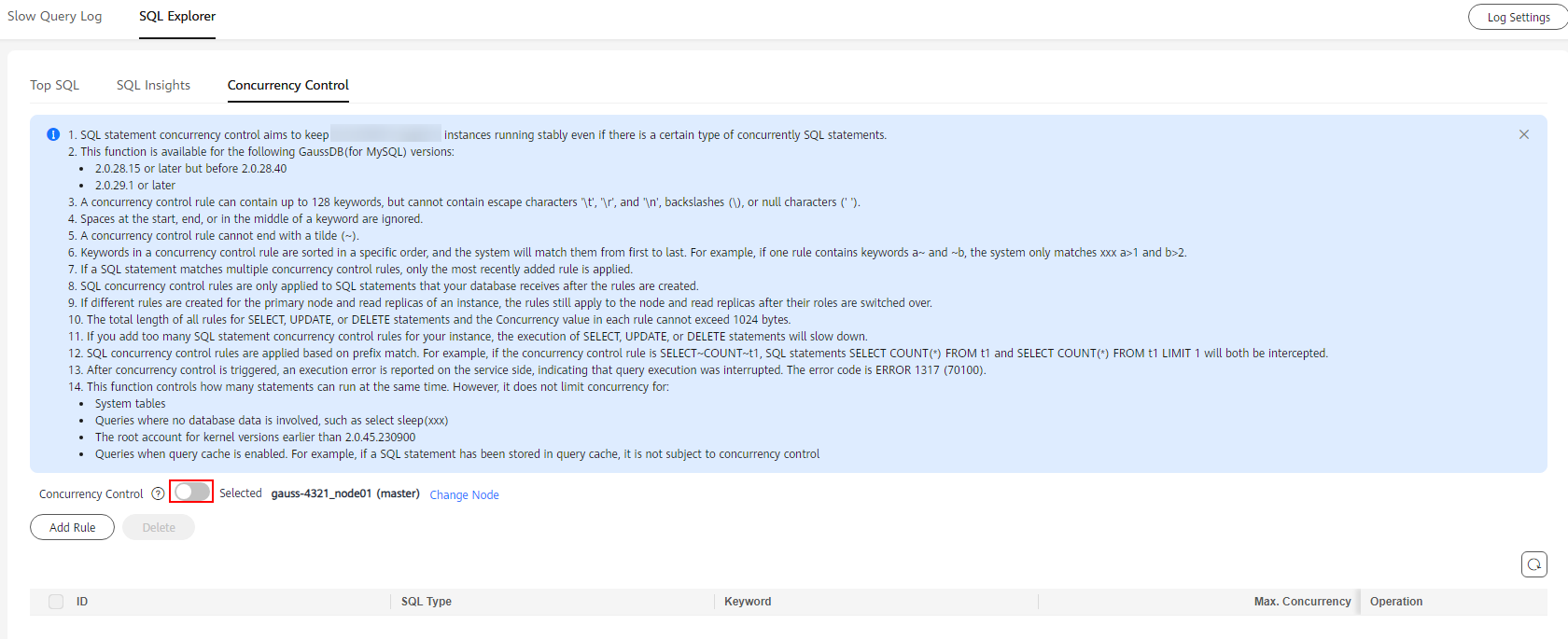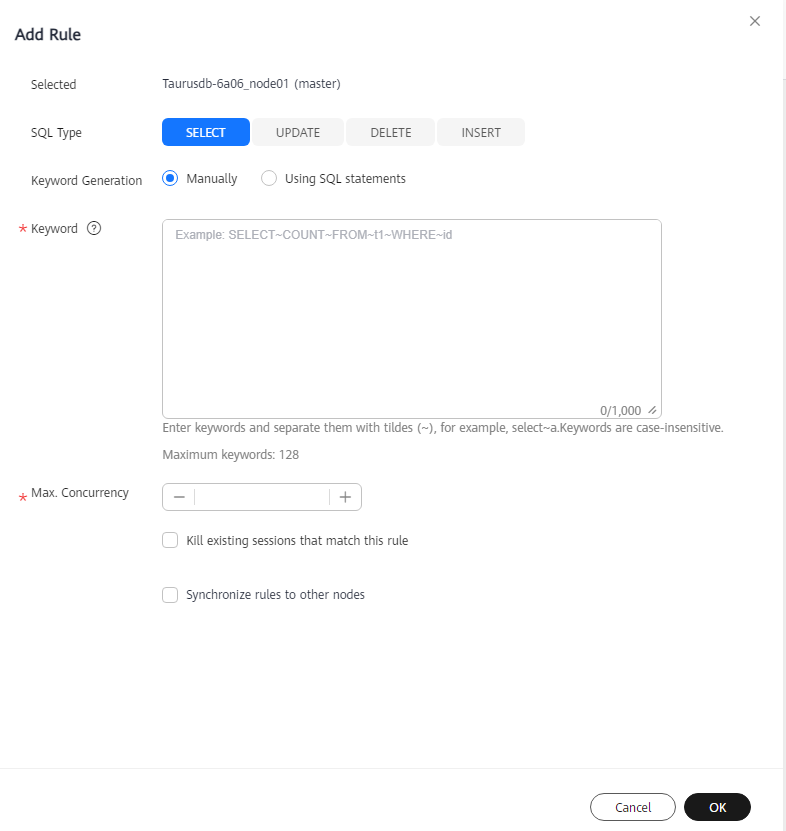Este conteúdo foi traduzido por máquina para sua conveniência e a Huawei Cloud não pode garantir que o conteúdo foi traduzido com precisão. Para exibir o conteúdo original, use o link no canto superior direito para mudar para a página em inglês.
Central de ajuda/
TaurusDB/
Guia de usuário/
Assistente de DBA/
Análise e ajuste de SQL/
Configuração do controle de simultaneidade de instrução SQL
Atualizado em 2025-05-23 GMT+08:00
Configuração do controle de simultaneidade de instrução SQL
Cenários
O controle de simultaneidade de instruções SQL visa manter as instâncias de TaurusDB funcionando de forma estável, mesmo que haja um aumento repentino nas instruções SQL simultâneas.
Restrições
- Essa função só está disponível para instâncias de TaurusDB que atendem aos seguintes requisitos:
- 2.0.28.40 > versão do kernel ≥ 2.0.28.15
- Versão do kernel ≥ 2.0.29.1
- As regras de controle de simultaneidade para instruções INSERT só são suportadas quando a versão do kernel da instância de TaurusDB é 2.0.54.240600 ou posterior.
- Uma única regra de controle de simultaneidade pode conter no máximo 128 palavras-chave.
- Barras invertidas simples (\) ou caracteres nulos simples (' ') não podem ser usadoscomo palavras-chave.
- Espaços no início e no final de uma palavra-chave e caracteres nulos especiais (como \'t', \'r' e \'n') serão ignorados.
- Uma regra de controle de concorrência não pode terminar com um til (~).
- As palavras-chave em uma regra de controle de simultaneidade são classificadas em uma ordem específica e o sistema irá combiná-las da primeira à última. Por exemplo, se uma regra contém a palavra-chave a~and~b, o sistema corresponde apenas xxx a>1 and b>2.
- Cada regra de controle de simultaneidade SQL se aplica somente às instruções SQL que o banco de dados recebeu após a criação da regra.
- Se regras diferentes forem criadas para o nó primário e réplicas de leitura de uma instância de banco de dados, as regras ainda se aplicarão ao nó primário e as réplicas de leitura depois que suas funções forem alteradas.
- Se uma instrução SQL corresponder a várias regras de controle de simultaneidade, somente a regra criada mais recentemente será aplicada.
- As instruções SQL que foram executadas antes da adição de uma regra de controle de simultaneidade não são contadas.
- Se a versão do kernel do TaurusDB for 2.0.54.240600 ou posterior, o comprimento total de todas as regras e consultas simultâneas de um único tipo de SQL (SELECT, UPDATE, DELETE ou INSERT) não poderá exceder 4.000 bytes. O comprimento de uma única regra não pode exceder 1.000 bytes.
- Se a versão do kernel do TaurusDB for anterior a 2.0.54.240600, o comprimento total de todas as regras e consultas simultâneas de um único tipo de SQL (SELECT, UPDATE ou DELETE) não poderá exceder 1.024 bytes.
- Se houver muitas regras de controle de simultaneidade, o desempenho das instruções SELECT, UPDATE, DELETE e INSERT se deteriorará.
- As regras de controle de simultaneidade SQL são aplicadas com base na correspondência de prefixo. Por exemplo, se a regra de controle de simultaneidade for SELECT~COUNT~t1, as instruções SQL SELECT COUNT(*) FROM t1 e SELECT COUNT(*) FROM t1 LIMIT 1 serão interceptadas.
- Após o controle de simultaneidade ser acionado, um erro de execução é relatado no lado do serviço, indicando que a execução da consulta foi interrompida. O código de erro é ERROR 1317 (70100).
- Esta função controla quantas instruções podem ser executadas ao mesmo tempo. No entanto, não limita a simultaneidade para:
- catálogo do sistema
- Consultas em que não há dados de banco de dados envolvidos, como select sleep(xxx)
- Conta root
- Instruções SQL em procedimentos armazenados, gatilhos e funções
Procedimento
- Faça logon no console de gerenciamento.
- Clique em
 no canto superior esquerdo e selecione uma região e um projeto.
no canto superior esquerdo e selecione uma região e um projeto. - Clique em
 no canto superior esquerdo da página e escolha Databases > TaurusDB.
no canto superior esquerdo da página e escolha Databases > TaurusDB. - Na página Instances, clique no nome da instância.
- No painel de navegação, escolha DBA Assistant > Historical Diagnosis.
- Escolha SQL Explorer > Concurrency Control.
- Na página exibida, habilite Concurrency Control.
Figura 1 Ativação do controle de simultaneidade de instruções SQL

- Clique em Add Rule. Na caixa de diálogo exibida, especifique SQL Type, Keyword e Max. Concurrency.
Figura 2 Adição de uma regra de controle de simultaneidade

- Keyword: você pode inserir palavras-chave ou copiar uma instrução SQL existente na caixa de texto e clicar em Generate Keyword.
Keyword: tome select~a como um exemplo. select e a são duas palavras-chave contidas em uma regra de controle de concorrência. As palavras-chave são separadas por um til (~). Neste exemplo, a regra restringe a execução apenas das instruções SQL que contêm as palavras-chave select e a.
- Max. Concurrency: as instruções SQL que atendem ao tipo e à palavra-chave de SQL especificados e excedem o valor de Max. Concurrency não serão executadas.
- Se você selecionar Kill existing sessions that meet this rule, as sessões que atendam à regra serão eliminadas.
- Se você selecionar Synchronize rules to other nodes, as novas regras poderão ser sincronizadas com outros nós na mesma instância.
- Keyword: você pode inserir palavras-chave ou copiar uma instrução SQL existente na caixa de texto e clicar em Generate Keyword.
- Confirme as configurações e clique em OK.
- Se uma regra de controle de concorrência não for necessária, selecione a regra e clique em Delete acima da lista de regras. Na caixa de diálogo exibida, clique em OK.
Tópico principal: Análise e ajuste de SQL
Feedback
Esta página foi útil?
Deixar um comentário
Obrigado por seus comentários. Estamos trabalhando para melhorar a documentação.
O sistema está ocupado. Tente novamente mais tarde.






